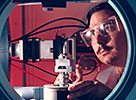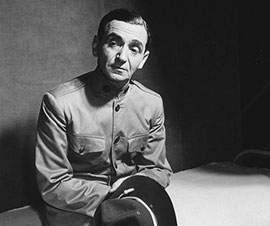- About Us
- Our History
-

Overview
Our origins as the first large-scale research facility in the north-eastern United States.
Discoveries
Brookhaven is home to discoveries that led to seven Nobel Prizes.
Unique Facilities
The Lab was conceived to design, construct and operate large scientific research machines.
-
- Awards
- Leadership Team
- Brookhaven Science Associates
- Stakeholder Relations
- External Code of Conduct

Camp Upton

The area of central Suffolk County presently occupied by Brookhaven National Laboratory once served the nation in a different manner. It was the site of the U.S. Army's Camp Upton, which was active from 1917 until 1920, and again from 1940 until 1946. During both world wars, Camp Upton helped train new soldiers and prepare them for major combat campaigns overseas. The Army was later to use the site as a convalescent and rehabilitation hospital for wounded veterans returning after World War II.
World War I
When the United States entered the First World War in 1917, a standing army was non-existent, and large forces would be needed to fight overseas. It was decided that sixteen cantonments would be erected across the country to train the New York area inductees. The proposed army base was to be named Camp Upton, after Civil War figure Major General Emery Upton.
Construction began in the summer of 1917. Fifty-five railroad cars of supplies were unloaded daily. Thousands of tons of lumber, nails, and stone arrived at the construction site. When the first 2,000 drafted men arrived on September 10th, two-thirds of the camp had yet to be completed. The new soldiers were put side by side with the laborers to help complete the camp. On December 20th, the camp was officially declared complete, and turned over to Camp Commander Major General J. Franklin Bell.

Camp Upton recruits practice bayonet drills.
The recruits who arrived at Upton came from New York, New Jersey and Connecticut, representing twenty-five or more national backgrounds and all walks of life. In all, some 40,000 men would spend some part of their military service at Upton. The completed camp actually doubled the population of Suffolk County.
In October, General Bell put into action a sixteen-week training program, which included almost every aspect of infantry combat. French and British officers were brought to the U.S. and instructed the men in tank, trench and gas warfare. The draftees trained in the use of hand grenades and machine guns, and professional boxers taught the men hand-to-hand combat.
From these raw recruits came the nucleus of the 77th Division. Officially formed before the first draftee arrived in camp, the 77th was to gain recognition for its valor at the Argonne Forest in August of 1918.
World War II
With the war's end in November of 1918, Upton's use was limited. The camp served as a demobilization site for returning veterans, but the Army soon decided that Camp Upton was of no further use, and it was deactivated. For almost twenty years, the site remained quiet as Upton National Forest. Then, in 1940, the Yaphank wilderness came to life again as the war in Europe and in the Pacific (of which America was not yet a part) gave rise to a drive for military preparation. Since the Yaphank land was still available, the decision was made to rebuild the camp. Once again, plans were drawn up for parade grounds, barracks, and other support facilities.
Once war was declared, the camp was again filled with men and machinery. But the camp was not used solely as an induction center. After the war effort moved from the European to the Pacific Theater, the induction center was moved to Fort Dix, N.J. The camp was then expanded to convert it into a convalescent and rehabilitation hospital in September of 1944. Bowling alleys, swimming pools, and tennis courts were added to serve as recreational therapy for the patients. Upton became a showcase for the type of treatment the returning wounded veterans would receive.

Soldiers in the World War II era queue up for a performance of "This is the Army" at Camp Upton.
The Birth of Brookhaven National Lab
The camp was again deemed unnecessary once combat in the Pacific ended, drawing a close to the Second World War. It was officially declared surplus. However, this time the base was not dismantled. A number of suggestions arose as to how the base and its facilities could be put to the best use, among them a plan to use Upton as a vocational school for the youth of Long Island. The final accepted proposal, however, called for the former army camp to be converted into a research center for the peaceful uses of atomic energy. Barracks were to house the equipment to be used by the scientists. Thus, in January 1947, Brookhaven National Laboratory was born, and Camp Upton had finally completed its service to the nation.

Brookhaven Lab main gate, circa late 1940s.





